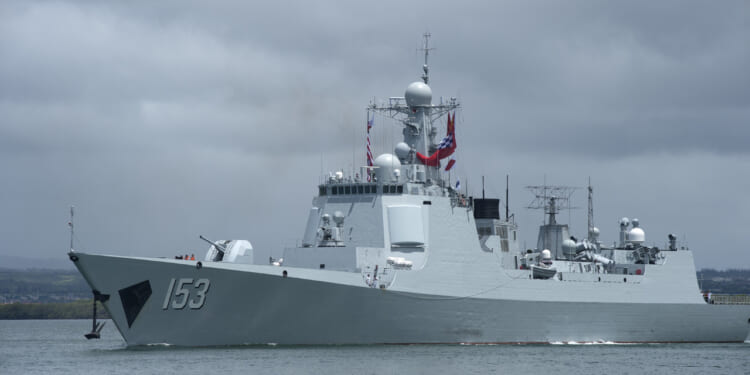The threat posed by warships like the Type 052C underscores the need for the United States to bolster its alliances.
The maritime menace imposed by the People’s Republic of China’s (PRC) People’s Liberation Army Navy (PLAN) grows more and more with each passing day. This is true in terms of sheer numbers—a shipbuilding capacity a whopping 232 times greater than the United States, as my National Interest colleague Brandon J. Weichert noted back in September 2024—acts of belligerence and technological capabilities alike.
One of the prime examples of the PLAN’s technological capabilities is the Type 052C (Luyang II-class) guided missile destroyer (DDG).
The Basics on the Type 052C
The inspiration for this article comes to us via the Sub Brief channel on MSN, in a video posted on or about April 13, 2025, titled “Exposing The Chinese Warship With A LOT of Weapons,” narrated by Sub Brief founder and CEO Aaron Amick (himself a retired U.S. Navy sonarman who served on both Los Angeles-class fast-attack submarines and Ohio-class nuclear ballistic missiles submarines).
As Amick states in the opening narrative of the video:
“All right, so this ship is very significant in the history of the Chinese Navy. The ship has been referred to as the Chinese Aegis. This is their entrance into the world of fleet protection, fleet command, if you will, command-and-control in the modern era. So, the mean difference between this Charlie [as in 052C, that is] and the 052B is the significantly upgraded AESA [Active Electronically Scanned Array] radar that was developed by Nanjing Research Institute of Technology. And it is based on the American radar and some of the radars that were coming out of the West like France’s radar as well. And they just tried to mimic what we were doing, and they were pretty successful out of this. This radar is capable, it has long range, it can track multiple contacts across a wide frequency … And adding command-and-control fleet command to a non-aircraft carrying, you know, or larger ship, is significant here. So this destroyer, 7,000 tons fully loaded, can coordinate an entire fleet.”
Additional Luyang-II History and Specifications
Built by the Jiangnan Shipyard (Group) Co. Ltd. in Shanghai, the Type 052C DDGs were built between 2002 and 2015. A total of six have been built, with the Lanzhou (Hull No. 170) as the first ship of the class, launched on April 29, 2003, and commissioned in July 2004.
Specifications and vital stats (in addition to the ones already covered by Amick) are as follows:
- Hull Length: 462 feet (140.82 meters)
- Beam Width: 55.8 feet (17 meters)
- Draught: 19.7 feet (6 meters)
- Propulsion: CODOG (combined diesel or gas) configuration generating up to 57,000 shaft hp to two shafts
- Max Speed: 30 knots (34.5 mph)
- Range: 4,000 nautical miles at 18 knots
- Crew Complement: Between 220 and 280 (depending on which source you consult) commissioned officers and forty-five enlisted sailors
- Armament:
- One 100mm Type 210 dual-purpose DP) turreted deck gun
- One 48-cell HHQ-9 surface-to-air missile (SAMs)
- Eight YJ-8/C-805 (NATO reporting name: CSS-N-4 Sardine) cruise missiles, HN-2, YJ-62 anti-ship/land-attack cruise missiles
- Two Type 730 CIWS (Close-In Weapons System)
- Six 533mm torpedo tubes
- Four 18 decoy launchers
Where To From Here?
The threat posed by PLAN warships like the Type 052C underscores the need for the United States to: maintain and bolster its partnerships with its allies in the Indo-Pacific via venues such as AUKUS and the Quad and so forth), and bolster its underserved shipbuilding community which has lagged behind for far too long. Regarding the latter, we’re fortunately starting to finally see some encouraging signs via President Donald Trump’s announcement back on March 4, 2025, establishing a new office of shipbuilding within the White House, along with a new executive order calling on U.S. senior leadership to create a maritime action plan by November.
About the Author: Christian D. Orr
Christian D. Orr was previously a Senior Defense Editor for National Security Journal (NSJ) and 19FortyFive. He is a former Air Force Security Forces officer, Federal law enforcement officer, and private military contractor (with assignments worked in Iraq, the United Arab Emirates, Kosovo, Japan, Germany, and the Pentagon). Chris holds a B.A. in International Relations from the University of Southern California (USC) and an M.A. in Intelligence Studies (concentration in Terrorism Studies) from American Military University (AMU). He has also been published in The Daily Torch, The Journal of Intelligence and Cyber Security, and Simple Flying. Last but not least, he is a Companion of the Order of the Naval Order of the United States (NOUS). If you’d like to pick his brain further, you can ofttimes find him at the Old Virginia Tobacco Company (OVTC) lounge in Manassas, Virginia, partaking of fine stogies and good quality human camaraderie.
Image: Wikimedia Commons.
















